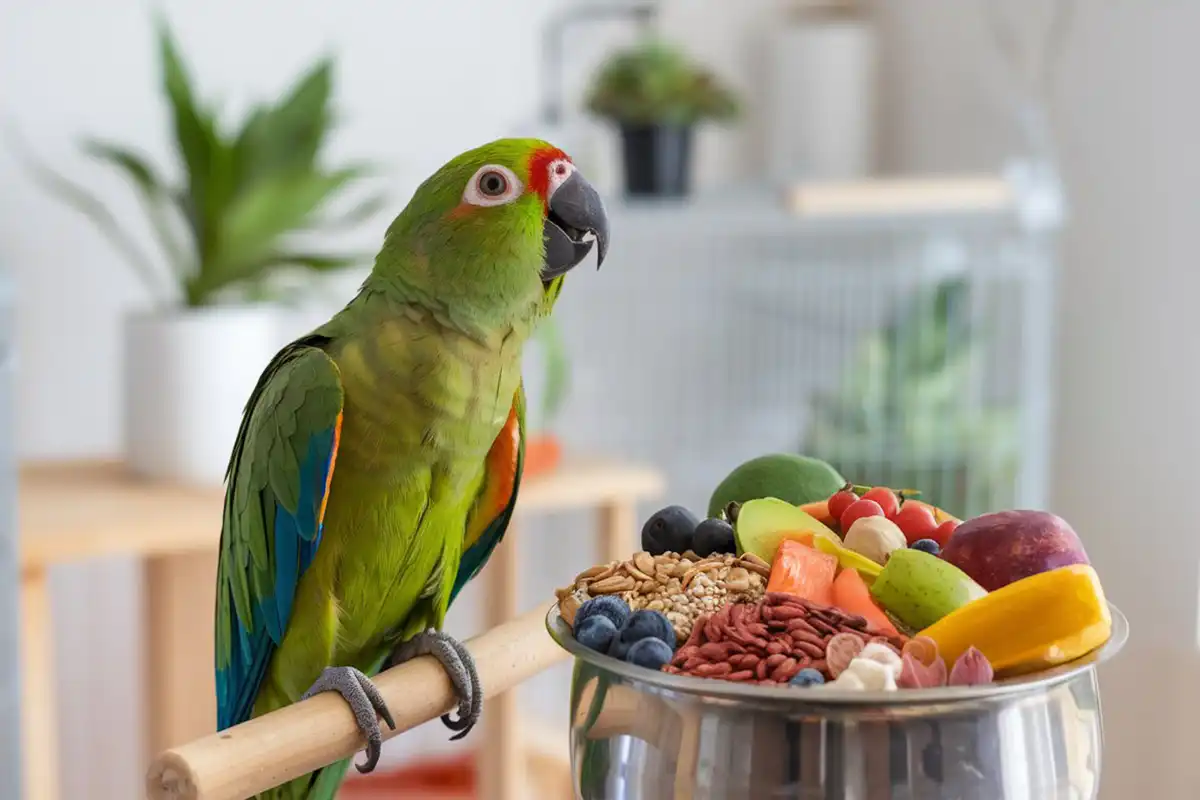Feeding your feathered friend the right diet is one of the most important ways to ensure they live a long, healthy, and vibrant life. If you’ve recently adopted a parrot or you’re looking to upgrade your bird’s meals, this Green Parrot Food List will help you make informed, nutritious choices. Green parrots—whether you have an Indian Ringneck, an Amazon Parrot, or another green-feathered companion—thrive on a balanced and varied diet that mimics what they would eat in the wild.
Many parrot owners struggle to find the right balance between seeds, pellets, fresh produce, and supplements. There is a lot of different information available, which can make you feel confused and overwhelmed. That’s why we’ve created this simple, clear guide that breaks down what to feed your green parrot, what to avoid, and how to build a healthy daily routine. Whether you’re new to parrot care or just want to fine-tune your bird’s menu, this comprehensive guide will give you everything you need to raise a happy, colorful companion.
Understanding the Green Parrot’s Nutritional Needs
What do green parrots eat? (Overview of a balanced parrot diet)
Green parrots eat a wide range of foods in the wild, including seeds, nuts, berries, fruits, flowers, and leafy greens. Their natural diet is full of variety, which helps them meet their nutritional needs while keeping them mentally stimulated. When you care for a green parrot at home, you need to replicate that variety with a carefully planned diet that includes high-quality parrot pellets, fresh fruits and vegetables, a controlled amount of seeds or nuts, and occasional natural treats. Each food group serves a purpose: pellets provide balanced daily nutrition, veggies supply essential vitamins, and small portions of seeds or nuts offer healthy fats and protein.
A well-rounded Green Parrot Food List should focus on delivering all the necessary nutrients while keeping meals interesting and species-appropriate. Always ensure fresh, clean water is available alongside their food to support digestion and hydration.
Differences between species: Indian Ringneck vs Amazon Parrot dietary preferences
Even though both are green parrots, the Indian Ringneck and the Amazon Parrot have different dietary preferences and requirements. Indian Ringnecks tend to be more selective eaters and often prefer crunchy vegetables like carrots, broccoli, and bell peppers. They also enjoy a mix of soft fruits like mango, apples (without seeds), and papaya. These birds have a fast metabolism, so they benefit from nutrient-dense meals in smaller portions. In contrast, Amazon Parrots are generally more robust and enthusiastic eaters. However, they are also more prone to obesity, so their intake of fatty seeds and sugary fruits should be closely monitored.
Amazon Parrots thrive on a diet that emphasizes fiber-rich greens, vitamin-rich vegetables, and moderate portions of fruit. Tailoring your Green Parrot Food List to fit the specific needs of each species helps you avoid health issues and ensure your bird gets the right balance of energy, vitamins, and minerals every day.
Why nutrition matters for parrot health, mood, and feather quality
The phrase “you are what you eat” is very true for parrots. This means that the food they eat affects their health and happiness. Nutrition plays a direct role in your bird’s overall health, behavior, and appearance. A diet lacking in essential nutrients can lead to feather plucking, poor coloration, irritability, lethargy, and even life-threatening conditions like fatty liver disease or calcium deficiency. On the other hand, when parrots eat a varied, nutrient-rich diet, they become more active, their feathers stay glossy and vibrant, and their mood stabilizes.
Foods high in Vitamin A, such as sweet potatoes, kale, and red peppers, help support healthy feather regeneration and strengthen the immune system. Calcium-rich foods and supplements like cuttlebone or crushed eggshell help support strong bones and proper nerve function, especially in egg-laying females. By thoughtfully creating your Green Parrot Food List, you lay the groundwork for a longer, happier, and healthier life for your bird. Every meal you offer is an opportunity to support your parrot’s well-being from the inside out.
Parrot nutrition tips from avian experts
Avian veterinarians and bird nutrition specialists agree on one thing: consistency and variety are key to a thriving parrot. Experts recommend using high-quality parrot pellets as the foundation of your bird’s diet, making up about 60–70% of their daily food. Pellets offer a complete nutritional profile and reduce the risk of selective eating, which is common when parrots are fed only seed mixes. The remaining portion of your parrot’s diet should consist of fresh, colorful fruits and vegetables—ideally rotated weekly to introduce new textures, flavors, and nutrients.
Offer dark leafy greens like Swiss chard and collard greens for calcium and iron, and fruits like berries and kiwi for antioxidants. Experts also caution against offering human snacks or processed foods, as these can harm your bird’s digestive system and lead to long-term health problems. Incorporating these expert-backed tips into your Green Parrot Food List ensures your parrot gets optimal nutrition, mental enrichment, and daily enjoyment from their meals.
Green Parrot Food List: Healthy Staples to Include
Best food for green parrots: Whole foods and daily essentials
Green parrots thrive on a diet packed with fresh, whole foods that mirror what they would naturally forage in the wild. While commercial bird food can serve as a base, whole foods offer essential nutrients and texture variety that processed options often lack. The best daily staples include high-quality parrot pellets, fresh vegetables, clean fruits, and a small portion of healthy seeds or nuts. Leafy greens like spinach, kale, and collard greens provide vital minerals, while crunchy vegetables like bell peppers and carrots are rich in antioxidants. Fruits like apple slices (without seeds), berries, and melon make great low-fat, energy-boosting treats. Always wash produce thoroughly and chop it into safe, manageable pieces. By building your Green Parrot Food List around these whole food essentials, you set up your bird for long-term health, energy, and natural foraging enjoyment.
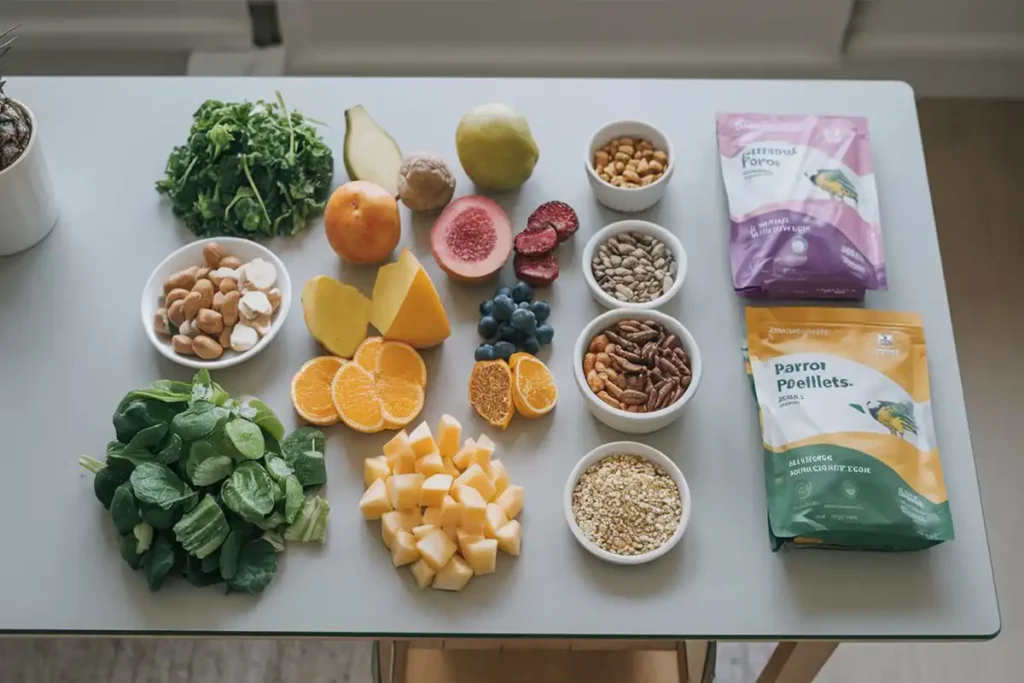
Parrot-safe fruits and vegetables (e.g., apples, carrots, kale)
Fruits and vegetables play a huge role in your green parrot’s daily diet, offering hydration, vitamins, and variety. However, not all produce is safe for parrots, so you need to choose options carefully. Safe fruits include apples (seedless), bananas, berries, mango, kiwi, papaya, melon, and pears. These fruits should be served in moderation due to their natural sugar content. On the veggie side, go for carrots, sweet potatoes, broccoli, bell peppers, and leafy greens like kale and Swiss chard. These vegetables provide a rich source of Vitamin A, calcium, and fiber. Avoid giving onions, garlic, rhubarb, or mushrooms, as these can be toxic to birds. A strong Green Parrot Food List will feature these safe fruits and vegetables regularly, rotating options each week to keep meals exciting and nutritionally balanced.
Natural parrot food options: Whole grains, legumes, and sprouts
Incorporating natural plant-based foods like whole grains, cooked legumes, and sprouts into your parrot’s diet boosts both nutrition and enrichment. Whole grains such as brown rice, quinoa, barley, and oats offer slow-release energy, B vitamins, and fiber. Cooked legumes like lentils, chickpeas, and black beans provide valuable plant-based protein and minerals, and they’re especially beneficial for parrots that are more active or in breeding condition. Sprouted seeds and beans are another excellent addition—sprouting boosts their nutritional value and makes them easier to digest. You can sprout mung beans, lentils, or even sunflower seeds at home with minimal effort. These natural foods help mimic the variety and challenge parrots enjoy when foraging. When you expand your Green Parrot Food List with these wholesome ingredients, you support better digestion, stronger immunity, and mental stimulation.
The role of parrot pellets vs seeds in a balanced diet
Many new bird owners assume that seed mixes alone provide a complete diet, but that’s a common misconception. While seeds are natural and parrots do love them, they’re also high in fat and low in many essential nutrients. Parrot pellets, on the other hand, are specially formulated to deliver a complete and balanced nutritional profile. They should make up the bulk of your green parrot’s diet—ideally around 60–70%—with seeds offered only as occasional treats or training rewards. Pellets reduce the risk of nutrient deficiencies and discourage selective eating, a behavior that’s common with seed-only diets. Choose high-quality, species-appropriate pellets with minimal additives or artificial coloring. For a smart and healthy Green Parrot Food List, use pellets as the nutritional foundation and sprinkle in a variety of safe fruits, vegetables, and a few nuts or seeds for enrichment and variety.
Supplementing Your Parrot’s Diet for Optimal Health
Importance of calcium supplements and cuttlebones
Calcium plays a critical role in your green parrot’s health. It strengthens bones, supports proper muscle function, and helps regulate the nervous system. Female parrots especially need enough calcium to avoid egg binding and other reproductive issues. Even if your parrot eats calcium-rich foods like dark leafy greens and broccoli, it might still benefit from a calcium supplement. One of the easiest ways to offer extra calcium is through a cuttlebone, which also helps keep the beak trimmed. Mineral blocks and calcium-rich powder supplements are also useful, especially during molting or breeding seasons. When you create a thorough Green Parrot Food List, don’t forget to include a reliable calcium source to promote long-term skeletal health and vitality.
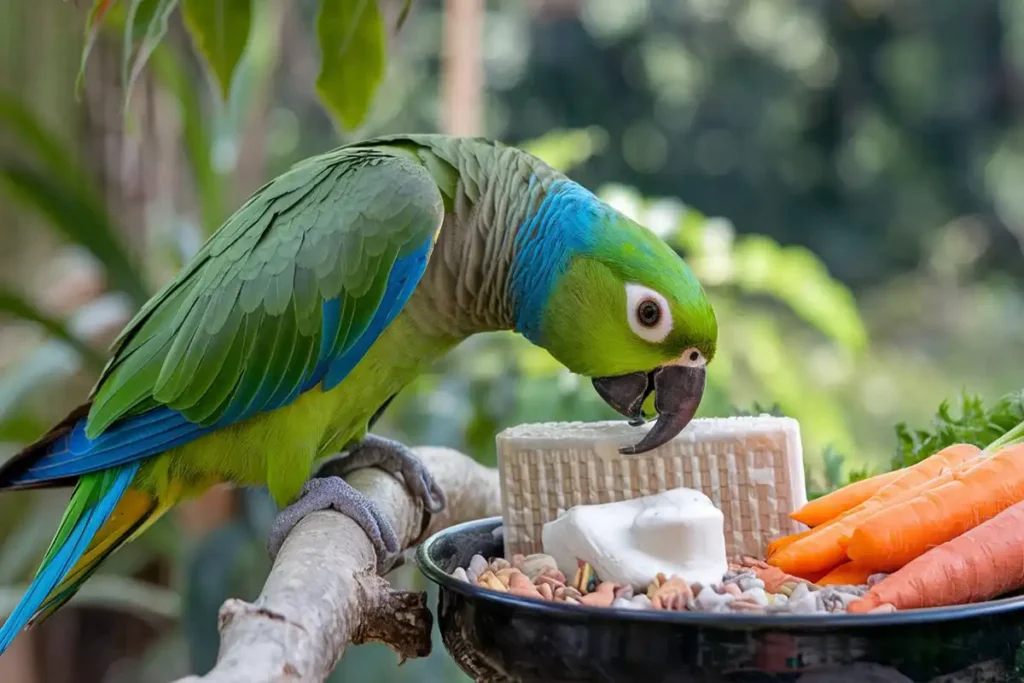
Boosting immunity with Vitamin A-rich foods (e.g., sweet potatoes)
Vitamin A is one of the most essential nutrients for parrots, and many birds suffer from Vitamin A deficiency without their owners realizing it. This deficiency can lead to respiratory issues, dull feathers, and a weakened immune system. You can prevent these problems by regularly offering Vitamin A-rich foods such as sweet potatoes, carrots, red bell peppers, pumpkin, and leafy greens like kale and dandelion greens. These colorful veggies contain beta-carotene, which the parrot’s body converts into usable Vitamin A. Feeding a wide variety of these vibrant vegetables strengthens your bird’s natural defenses and promotes better skin and feather health. Adding these to your Green Parrot Food List ensures your bird has the tools to fight off illness and maintain peak condition year-round.
When and how to use fortified bird seed mix
Bird seed mixes have their place in a parrot’s diet, but they shouldn’t be the main course. Most commercial seed blends lack important vitamins and minerals, and many parrots selectively eat only the tastiest (and least nutritious) parts. Fortified bird seed mixes can help bridge the gap, especially when used as a supplement to a pellet-based diet. Look for mixes that include added vitamins and minerals, or blend seeds with pellets to encourage a more balanced intake. You can also use seed mixes strategically—as rewards during training sessions or for encouraging foraging behavior in puzzle toys. When you include fortified seed mixes thoughtfully in your Green Parrot Food List, you add a fun, flavorful option that supports enrichment while keeping nutrition in check.
Hydration and the importance of clean water
Water might seem like a basic need, but it’s just as important as any food you serve. Parrots need constant access to fresh, clean water to stay hydrated, regulate their body temperature, and support digestion. Dirty or stale water can quickly become a breeding ground for harmful bacteria, so you should change it at least once or twice daily. On hot days or when feeding dry foods like pellets or seeds, your parrot may drink even more. Some green parrots also enjoy dipping their food in water, so a sturdy, tip-proof dish is ideal. Including good hydration habits in your Green Parrot Food List doesn’t just mean offering the right food—it also means supporting your bird with clean water at all times for optimal health.
Toxic Foods to Avoid in a Green Parrot’s Diet
Avocado: Why it’s dangerous for parrots
Avocados may be a superfood for humans, but they’re extremely dangerous for parrots. Even a small amount of avocado can be toxic to birds, especially the flesh and skin. The culprit is a substance called persin, which can cause heart failure, difficulty breathing, and even sudden death in parrots. Some owners may think that a tiny bite won’t hurt, but it’s not worth the risk. Never include avocado in your parrot’s meals, no matter how curious your bird may be. When you’re building a safe and responsible Green Parrot Food List, always treat avocado as completely off-limits and educate anyone else who feeds your bird to do the same.
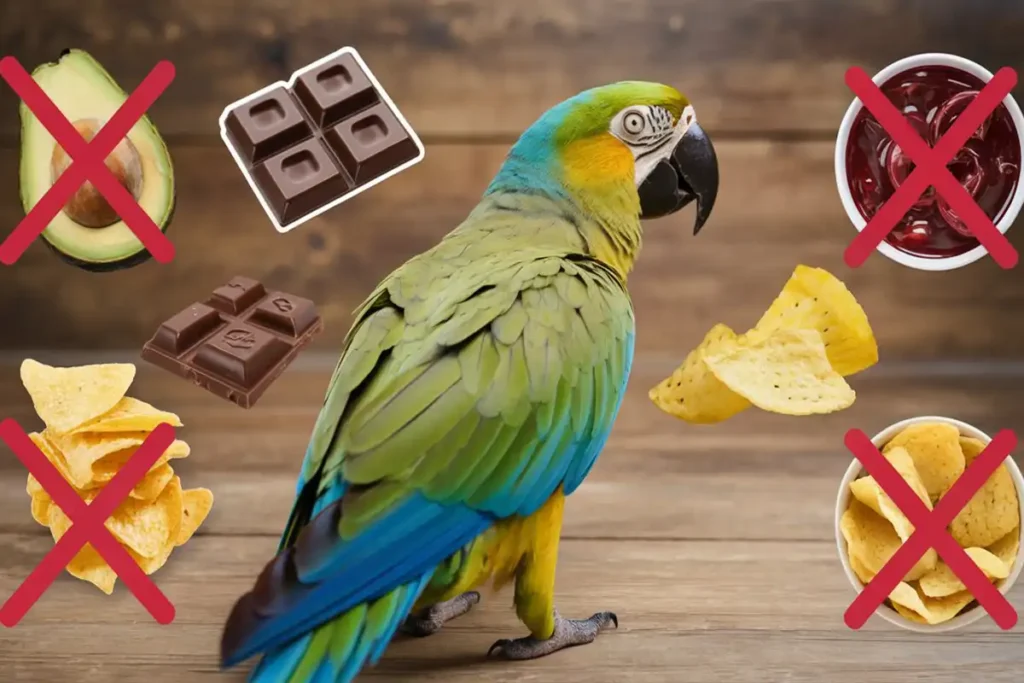
Chocolate, caffeine, and alcohol: Hidden household toxins
Many common human treats are highly toxic to parrots—especially chocolate, caffeine, and alcohol. Chocolate contains theobromine and caffeine, both of which can overstimulate a parrot’s nervous system, leading to tremors, seizures, or cardiac arrest. Caffeinated drinks like coffee, tea, or soda can cause similar reactions. Alcohol, even in small amounts, affects a bird’s liver and neurological system far more severely than it does in humans. Accidental exposure often happens when these items are left unattended or shared out of curiosity. You should never allow these substances near your bird, and make sure guests understand the danger too. A safe and effective Green Parrot Food List always excludes these toxic items and prioritizes natural, bird-appropriate foods instead.
Salty, sugary, or fried foods: Why processed snacks are harmful
While it might seem harmless to share a chip or a piece of cookie with your bird, salty, sugary, and fried foods can quickly lead to serious health problems. Parrots have small kidneys that struggle to process excess sodium, which can lead to dehydration or even kidney failure. Sugary snacks disrupt blood sugar levels, and over time, they can contribute to obesity and metabolic issues. Fried and greasy foods introduce unhealthy fats and can damage your bird’s liver. Processed snacks offer little to no nutritional value and create unhealthy eating habits. Instead of sharing your snacks, stick to bird-safe treats like fresh fruit or a few unsalted nuts. A mindful Green Parrot Food List leaves out all processed human foods and focuses on clean, natural ingredients.
How to recognize signs of food-related illness in parrots
Parrots can’t tell you when something’s wrong, so it’s up to you to spot the signs of food-related illness early. If your bird has been exposed to a toxic food, you might notice symptoms like vomiting, lethargy, loss of appetite, diarrhea, or changes in droppings. Other warning signs include labored breathing, fluffed feathers, or uncharacteristic aggression. In some cases, symptoms appear quickly—especially with foods like avocado or chocolate. If you ever suspect your bird has ingested something toxic, contact an avian veterinarian immediately. Prevention is always better than treatment, which is why a well-researched Green Parrot Food List is so essential. When you stay informed and observant, you can protect your parrot from accidental poisoning and ensure a longer, safer life.
Feeding Tips & Daily Routine for a Happy Green Parrot
Creating a consistent feeding schedule
Parrots thrive on routine, and creating a consistent feeding schedule supports their physical and emotional well-being. When your parrot knows when to expect meals, it reduces anxiety, encourages healthy eating habits, and makes it easier to monitor their appetite for any sudden changes. Aim to feed your parrot twice a day—once in the morning and again in the evening. Offer fresh fruits, vegetables, and any cooked grains during the first feeding when your bird is most alert and active. Use the second feeding to top off pellets or add enrichment snacks like foraging toys with seeds. By keeping your Green Parrot Food List structured around a set schedule, you create a sense of security and help regulate your parrot’s digestive system and metabolism.
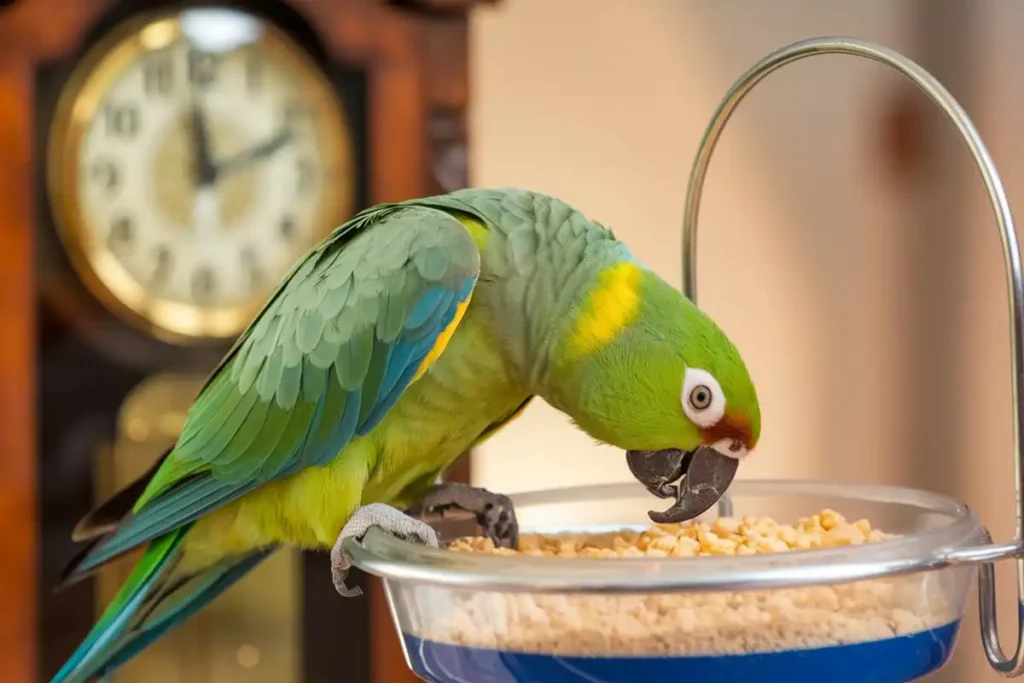
How much and how often to feed your parrot
Knowing how much to feed your green parrot can be tricky, but it’s key to preventing both underfeeding and obesity. The right amount depends on your bird’s species, size, activity level, and age. For most medium-sized green parrots, like Indian Ringnecks or Amazon Parrots, you should offer around ¼ to ½ cup of pellets daily, along with ⅛ to ¼ cup of fresh fruits and vegetables. Seeds and nuts should only make up about 5–10% of the diet, offered as occasional treats or during training. Avoid overfilling food bowls, as parrots often toss out what they don’t want. Watch your bird’s weight and eating habits over time and adjust as needed. Your Green Parrot Food List should reflect both quality and portion control to maintain a healthy, active bird.
Safe food preparation and storage practices
The way you prepare and store your parrot’s food can impact its freshness and safety. Always wash fruits and vegetables thoroughly to remove pesticides or dirt, and peel or core items like apples to avoid choking hazards or toxic seeds. Chop produce into small, manageable pieces that match your bird’s beak size. Avoid feeding anything that looks moldy, wilted, or spoiled. When preparing cooked items like grains or legumes, never use salt, oil, or spices. Store leftovers in airtight containers in the fridge and discard uneaten fresh food after a couple of hours to prevent bacterial growth. A clean kitchen routine supports a clean, safe diet, and every entry on your Green Parrot Food List should be handled with care to protect your bird from contamination or illness.
Encouraging foraging and natural feeding behaviors
Feeding isn’t just about nutrition—it’s also an opportunity to encourage your parrot’s natural behaviors. In the wild, parrots spend hours each day foraging for food. You can recreate this experience by hiding healthy treats in toys, shreddable paper, or even in branches and cardboard. Rotate the foraging setups regularly to keep your parrot mentally stimulated and engaged. Foraging also helps reduce boredom, aggression, and feather plucking. Use safe foods from your Green Parrot Food List—like chunks of carrot, leafy greens, or bits of nut—and turn mealtime into an enriching activity. This not only makes feeding fun but also builds confidence and promotes overall well-being.
Conclusion
Creating the right Green Parrot Food List can completely transform your bird’s health, mood, and quality of life. Your parrot depends on you to provide a diet that mimics the variety and nutrition found in the wild. When you offer a well-balanced mix of pellets, fresh fruits and vegetables, whole grains, and occasional treats, you give your parrot the fuel it needs to stay active, vocal, and vibrant.
Each green parrot species—whether it’s an Indian Ringneck, Amazon Parrot, or another variety—has unique preferences, but all need consistency, clean water, and nutrient-rich meals. A great Green Parrot Food List includes calcium-rich items like cuttlebones, immune-boosting foods high in Vitamin A, and fun foraging experiences to support mental health.
Just as important as what you include is knowing what to avoid. Steer clear of toxic foods like avocado, chocolate, and processed snacks. Feed clean, fresh meals, prepare them safely, and stick to a regular schedule your parrot can trust. Monitor their eating habits and adjust your Green Parrot Food List based on their age, health, and energy levels.
By staying informed and intentional with your bird’s diet, you build a foundation for a longer, healthier life. So don’t treat feeding like a routine task—treat it like an opportunity to bond, enrich, and care for your feathered friend. Start building your ideal Green Parrot Food List today, and watch your parrot thrive with every colorful bite.
Discover the best Parrot Food in this Article.
Learn About the Top 10 Small Parrots for New Owners Here.
Read About Other Pets and breeds From HERE!
Find Out the Best stuff for your Pet On Pet MD Official.
